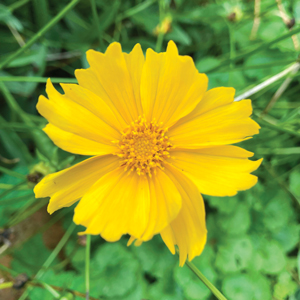Mt. Lebanon gardens on display

Early Saturday morning, July 9, I was on my way to visit a couple of gardens on the Mt. Lebanon Library Garden Tour. The tour, on Sunday, July 10, has been an ongoing event in Mt. Lebanon for many years and is an important fundraiser for the library. People come from far and wide to see these gardens and chat with the people who created them. Just like a musician develops new and different compositions with the same 88 keys of the keyboard, different gardeners use many of the same materials, and yet each garden is unique to the gardener. The atmosphere the Saturday before the tour is a bit like opening night at the theater. Countless hours of work have come and gone, the garden beds have been groomed, and experts have been consulted. Let the show begin!
My first stop was Rose Court Condominiums. I must admit that I was not prepared for what I found. Years ago, I remember these buildings in Central Square situated behind the Mt. Lebanon business district on Washington Road, as old, worn out, and lacking in charm. The landscaping consisted of vintage yews trimmed into big squares with a few half dead annuals scattered about. Not anymore. Now privately owned, these venerable old buildings could easily fit into the poshest neighborhood in Georgetown or Manhattan. They have been carefully revitalized, and the owners clearly love their homes.

I parked the car and stepped onto the cobblestone street, crossed over to the sidewalk and down the steps into one of the prettiest courtyard gardens I have ever been in. Three identical buildings come together to form a sizable courtyard. Several steps lead down from the street, and cement walkways lead to the front doors of each building, with a large common area in the middle. The burbling sound of a fountain echoes against the buildings. The garden beds are filled with blooming shrub roses and perennials; they are well mulched and weed free. The backdrop of larger shrubs, some of which have been in place since the buildings were built in 1940, complement the well-chosen new shrubs and trees. Several weeping Alaskan Cedars lend a bit of elegance. White pines, dogwoods and dwarf Alberta spruce, provide structure and maturity. Shrubs like rhododendrons, weigela, cotinus, clethra, and viburnums anchor the space, while blooming perennials like daisies, black eyed Susans, cone flowers, and Veronica provide a delicate speckling of color. Benches give guests a place to sit and ponder life. Very, very beautiful. Sue Hnath and Frances Robbins orchestrated this transformation, but these women did not stop there. They planted nearly every nook and cranny with rock gardens and shade gardens. Both women were raised in gardening families and say it comes naturally to them. Nicely done, ladies!
I then headed over to Mohawk Drive to see Margaret Hamstead’s garden. I found Margaret in her front yard working on a little detail that she declared must be taken care of before tour day. In fact, her front yard does not give a clue of what lies in the back yard. As I entered the garden in the rear of this lovely stone home, I was greeted with a happy mix of blooming shrubs, like oak leaf hydrangea, along with hostas, daylilies and daisies. Pots of annuals of zinnias, impatiens and tuberous begonias add a splash of color. Asiatic lilies all coming together to create a beautiful montage of color and texture. In a sunny corner, I noticed a vegetable garden thriving behind a chicken wire enclosure. Indeed, every little nook and cranny are planted.

This garden is also built on a slope, which allows the viewer from below to see it easily. Margaret beckoned me to come up a few steps into the garden and walk the paths. The paths not only allow for walking and keeping ones feet out of the beds, but also are an integral part of the design, drawing the eye and the visitor throughout the garden and sometimes adding a bit of mystery. Margaret has used stones to create a warren of paths that run through the garden like a vine runs up the chimney wall. Cobblestones, slate, irregular flagstone and gravel were all put to work. Paths also create visual interest in structure and texture, in this case structure, in a very cool way.
Finally I spent the day of the tour with my friend Anne Neel in her garden on Neulon Drive.

I have had the pleasure of watching the metamorphosis of Anne’s garden for several years. This garden has conditions common to many in this region; the house sits high above the street leaving a difficult front hillside to manage. It is terraced in the back with lovely flagstone patios and paths outside her sliding glass doors that lead the eye to a set of steps that go up again to a third tier where a hammock awaits, ready for a summer nap in the shade. Anne has certainly made the best of each level, creating private and public spaces that allow for entertaining a group or individual quiet reflection. The front hillside, planted three years ago, has myriad lovely flowering shrub roses, spirea, a dwarf peach and ground cover evergreens. Added to that, daisies, cone flowers, liriope, clematis and ornamental grasses. The diversity of plants keeps this hillside pretty all year long. Rocks have been installed to allow her footholds for weeding and trimming. The front hill was the most daunting task of all. It was a weedy mess with landscape cloth embedded in the soil. The weeds were pulled and the landscape cloth eradicated before the new planting went in. Once the shrubs and perennials mature, they will fill in and eventually give her the weed suppressing shade she needs.
Anne has been gardening most of her life and knows what she likes and what she doesn’t. Her style is natural and free; she likes to let plants re-seed with abandon, especially her favorite namesake “Sweet Annie” (artemesia annua). To quote Mother Earth Living magazine, “Sweet Annie is the ‘tomboy’ of the everlasting garden because she is slow to germinate, late to bloom, and somewhat plain and gawky. And yet she is a favorite of crafters for her versatility and sweet lingering fragrance” and also of Anne Neel who loves to brush past it and experience Annie’s sweet scent.
It is commonly thought that July is a less than desirable time to host a garden tour, but these three gardens certainly show what a beautiful place a garden can be this time of year. I find it to be one of the best times—summer has settled in, the business of May and June with their grad parties and celebrations has dissipated, and it is great to see what’s blooming. If one of the attributes of a great garden is succession of bloom, then these gardens have certainly achieved.





